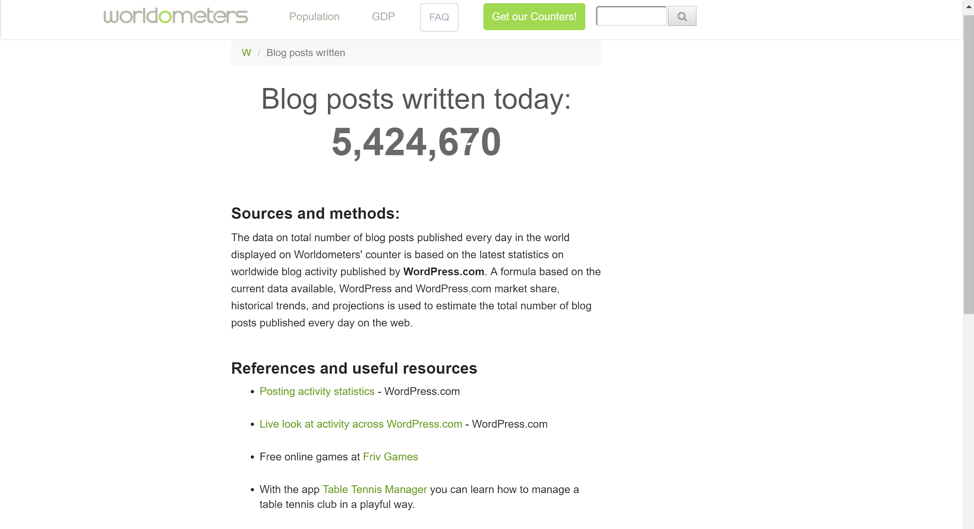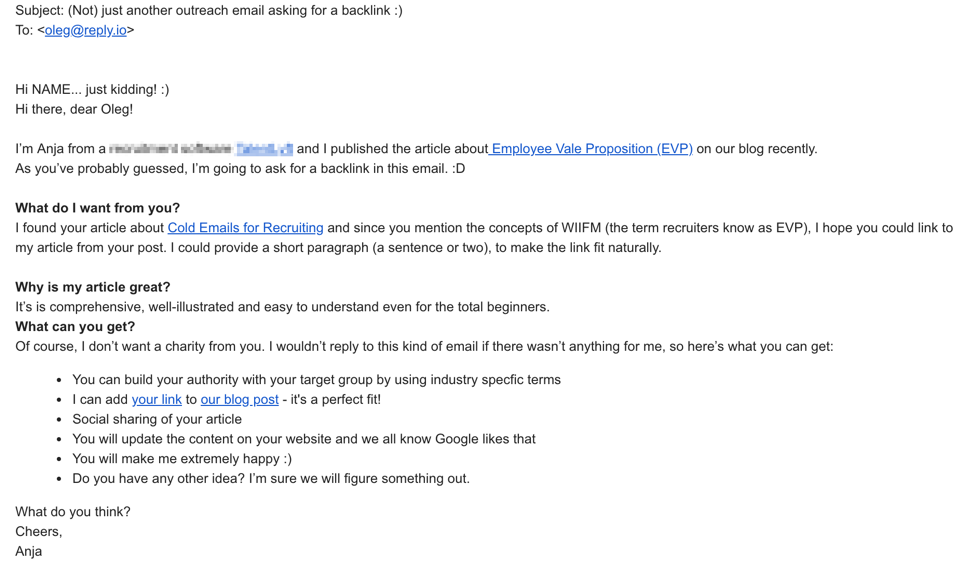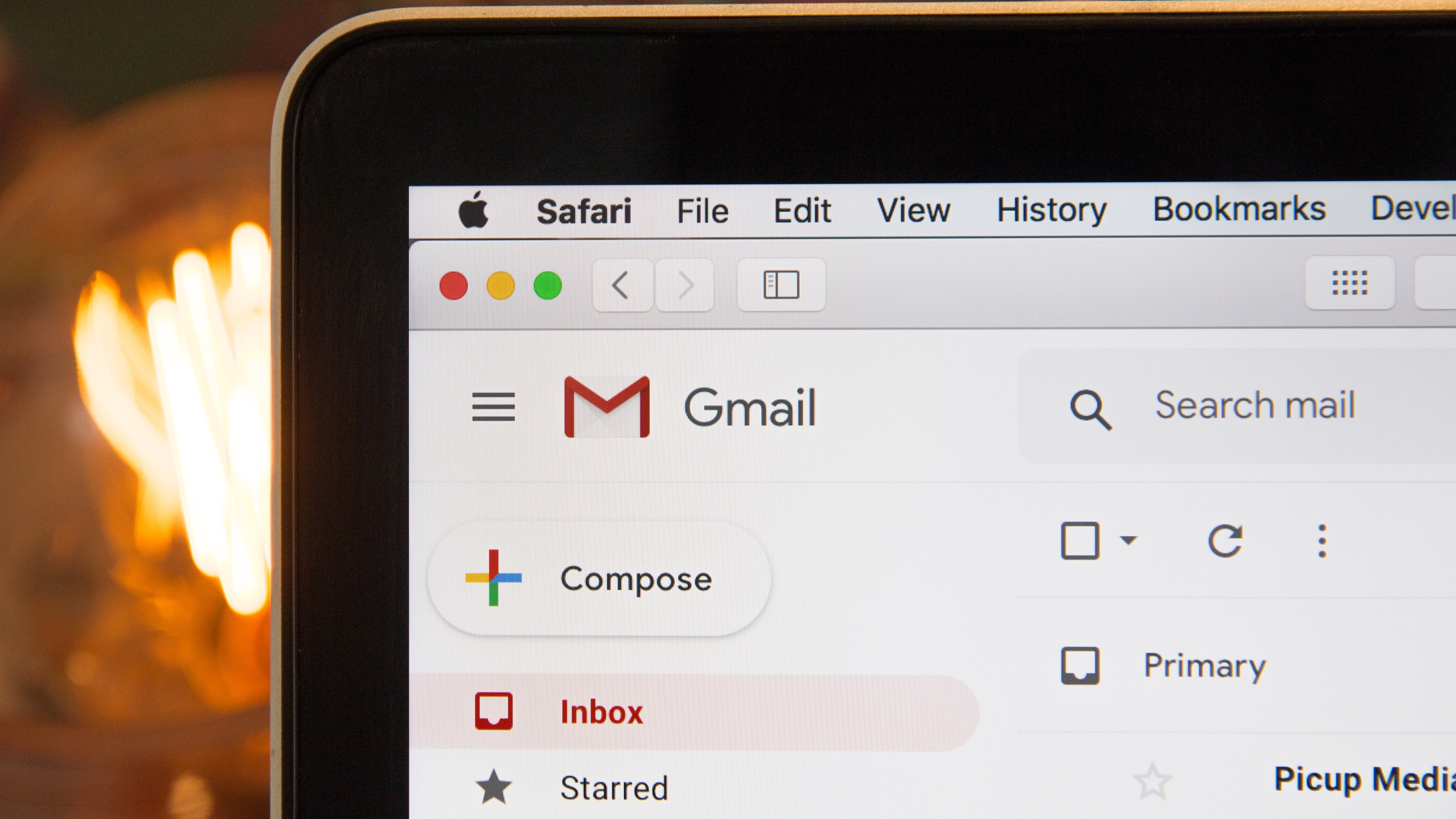Content may be king, but what good is that if nobody sees it?
With more than 5 million blog posts being published every single day, it’s not enough to just write an article or post a video and sit back while you wait for it to go viral. If you want your content to be seen, you’re going to need more than just great work.

If you want to build inbound links, see your content shared around the internet, and generate more buzz than a chainsaw, the most effective way is with outreach emails.
In this post, we’ll talk you through some of the different tactics and strategies you can use to improve your content performance and actually benefit from your hard work.
1. Know your goal
Before you sit down to write an outreach email, it’s vital to think about your goals.
This includes what your goals aren’t. In your quest to get more eyes on your content, you could inadvertently hurt your site’s ranking in the search results. Google warns that the following strategies could do more harm than good, so avoid:
- Buying or selling links that pass PageRank. This includes exchanging money for links, or posts that contain links; exchanging goods or services for links; or sending someone a “free” product in exchange for them writing about it and including a link
- Excessive link exchanges (“Link to me and I’ll link to you”) or partner pages exclusively for the sake of cross-linking
- Large-scale article marketing or guest posting campaigns with keyword-rich anchor text links
- Using automated programs or services to create links to your site
- Requiring a link as part of a Terms of Service, contract, or similar arrangement without allowing a third-party content owner the choice of using nofollow or other method of blocking PageRank, should they wish.
With that in mind, what should the goal for your outreach email be?
Spoiler alert: It’s not to get a link.
Your primary goal should be to create enough interest in your content that the recipient will read it.
While not asking for a link may sound crazy, the purpose of a first email should never be to seal the deal. Email is incredibly powerful, but it has limits. Asking for a link in your first email is like proposing on the first date. Instead, try and start a conversation. Keeping that in mind, where should you start looking?
2. Find the right place to promote your content
Who specifically should reach out to? Should you shoot for the stars and start writing that email to Bill Gates? Or should you go for a machine-gun approach and reach out to anyone with a website?
Tim Soulo at Ahrefs breaks down potential influencers into four groups:
- Sharks – People with a massive audiences—a link from them is incredibly valuable (and could potentially crash your site) but is also next to impossible to get.
- Big fish – Not as famous as the Sharks, but their audience is big enough to have a significant impact on your business.
- Small fish – They may not have the big audience you hoped for (yet), but they’re starting to get traction and are on the lookout for good content to share.
- Spawn – Just starting out, they don’t have any influence, or any traffic to send your way.
It’s almost impossible to even get your email seen by a Shark, while the influence of Spawn means it’s not worth the effort of emailing them. Using this classification, Tim recommends focusing your outreach efforts on the Small fish and Big fish.
You can further narrow down your list of prospective influencers by looking for sites where your content will be most useful. For example, online marketer Mike Wood recommends looking for websites with a resource page specific to your topic.
These pages typically already have plenty of outbound links pointing to helpful content, so if you have something useful to share your odds of getting a backlink are much better.
Of course, it’s great to find an influencer or site that’s right for you, but are you right for them?
3. Know their why
The people you want to promote your work to are likely already overwhelmed with hundreds of emails asking them for a link or social share. How can you stand out, and improve your chances of a positive response?
You need to know what they’re looking for.
At a basic level, it’s safe to assume that an influencer would want high-quality content that makes them look good. On the flip side, they certainly wouldn’t want to promote half-baked posts that reflect poorly on them.
Whatever content you want them to promote has to be epic. ‘Good enough’ is most definitely not good enough.
Obvious spelling and grammatical errors are a definite no, but that’s just the beginning. Your content has to be outstanding in the most literal sense, with unique insights and viewpoints, offering clear value to their audience.
Create content that will complement what they’re talking about (not just repeat it) and you’ll make them look good to their followers.
4. Build relationships beforehand
The biggest mistake I see people make with outreach emails is reaching out and asking for something from people who’ve never heard of you.
Everything you do to promote your blog posts will be far more effective if you take the time to build better relationships through direct engagement and giving something before you need anything from them.
How exactly do you build a relationship with someone you’ve never spoken to before?
There’s no shortcut, but there are several steps you can take that will help:
- Leverage your existing network. Are there any shared connections who could introduce you?
- Engaging with their existing content. Post meaningful, helpful comments on their posts.
- Promoting their content. Make sure you’re sharing their content with your audience before you expect them to do the same for you.
It may seem like a lot of work, but it pays off. Marketer and entrepreneur Sujan Patel has found that ‘real two-way relationships are far more scalable, require less work, and will provide better results as your blog grows.’
5. Send a personalized outreach email
Once you’re on their radar, you’re ready to reach out. To write an effective outreach email, put yourself in the recipient’s shoes.
Ask yourself if you would open the email if it landed in your inbox. Would you read it? How would it make you feel? Does it read like a sleazy used-car salesman, trying to trick you into doing what they want? Or does it feel original and worth following up on?
A small but important step is using their name. Starting your email with ‘Dear Sir/Madam’ is the quickest way to get your email deleted. You should also make sure you send your email to their most used email address, rather than the company’s generic email address.
When it comes to the actual message, is it better to write the message from scratch, or use a template?
We’re big fans of templates and often use them to get past the horrors of the blank screen. They’re also essential if you’re planning to scale your outreach; writing hundreds of emails from scratch is incredibly time-consuming. But it’s important to be careful and use them properly. The email still needs to be personal if it’s going to work, and you don’t get that by just filling in blanks for the recipient’s name.
Even the most successful templates lose their effectiveness over time as more people use them, victims of their own success. If you want your email to stand out, it needs to look different from the others filling their inbox. While you can still use a template, it’s important to take the time to truly personalize it and make it authentic.

This starts by including details you only could’ve found through research. For example, if in your relationship-building you saw they publicly declared their excitement for a new technology, or their disappointment in the season finale of their favorite TV show, go ahead and reference that in your email (however, use common sense. If you reference their holiday snaps from their personal Instagram account from nine years ago, you quickly cross the line from cool fan to creepy stalker).
If you decide to use any kind of ego boost (“I loved your post on XYZ”), make sure it’s genuine. Fake flattery is easy to spot and completely off-putting. On the other hand, if you’ve already shared and/or commented on their content beforehand, or you can give a specific example of how their content has helped you, your email will come across as much more legitimate.

Still not sure what to write? Use the following outline to get started.
- Greeting: Hi {First.Name},
- Why you’re reaching out to them (including proof of research): I’m a huge fan of your post on {Topic}—I had to share it with my {Social.Site} network, and implementing {Key.Takeaway} resulted in {Tangible.Benefit}.
- Who you are and what you can offer: I’ve actually written a post on {Topic} that {Explain how your content complements theirs}.
- CTA: Would you be interested in reading it?
For more templates, be sure to download Mention’s bundle of awesome outreach templates.
6. Follow up
One of the big mistakes people make when reaching out to influencers is never following up. If you’ve followed the advice in this post, you won’t have actually shared your content in your first email and you’ve simply started a conversation.
This means that you’ll have to follow up on your initial email.
To accomplish this, Brian Dean (founder of Backlinko) recommends using a Yes Ladder, where you get the person to say “yes” to a number of smaller requests before making your pitch. That means instead of immediately asking someone to share your post, you first ask them if they want to see it.
When they say yes, send them a link and ask for their feedback.
Once they’ve done that, ask them if they’d mind sharing the post with their audience.
As a result, they’re more likely to say “yes” to your link request. Brian found these “Feeler” emails got 40% more responses, as opposed to asking for a link in the first email (If you’re interested in reading more on why this works, I highly recommend Cialdini’s book Influence, especially the chapter on Consistency).
But what happens if you don’t get a response? Then you still need to follow up. People miss emails for all kinds of reasons, or simply run out of time to respond, so don’t feel guilty about sending a follow-up email. If you have that unique, valuable content (you do have that, right?) then you’re doing them a favor by following up.
What actually goes into a follow-up email?
Some prefer to simply forward their original email, with a quick “Just checking if you saw this.” Personally, I think you can do better. Use the follow-up as an option to try an alternative approach; for example, if your initial email focused on how your content complements their post, use the follow-up to focus on why their audience would specifically benefit from your content. Give them another reason to respond. Alternatively, if you are using a Yes ladder, you could always follow up with a link to the content, whether they’ve replied or not.
It’s vital not to burn your bridges with a potential influencer. Even if they’re not interested now, they might be interested in your next post, so keep it to one or two follow-ups max.
7. Use the right tools for the job
It’s possible to send out effective outreach emails using nothing more than a web browser and your email account, but it’s easier and more effective if you use the tools available. Here are some of the ones we recommend as essential.
Research – Buzzsumo can help you find influencers in your field, as well as get a feel for what content is most popular. Clearbit can help you learn more about what influencers are interested in and talking about. And of course, we have to mention Mention, perfect for keeping track of people who are already talking about your business, meaning they’re more likely to promote your content.
Email addresses – Name2Email and Hunter.io are both helpful in finding and validating those hard-to-find personal emails.
Email Outreach – Using an email automation tool like Reply makes it easier to keep track of open/reply rates and scale up your email sending.
Conclusion
The competition may be fierce, but it’s still possible to generate buzz for your content with outreach emails. By having a clear goal, keeping in mind how the recipient can benefit from your content, and sending personalized emails, you stand a much better chance of seeing your content promoted and increasing your traffic.






